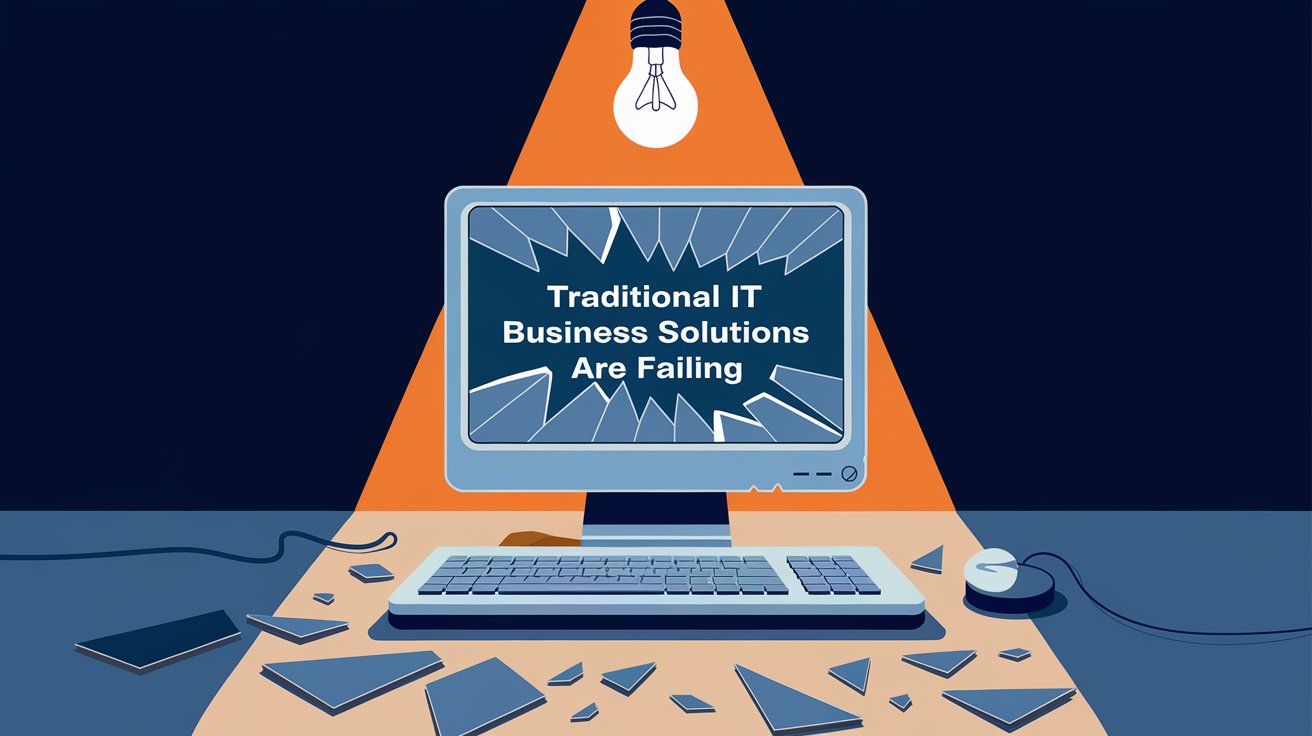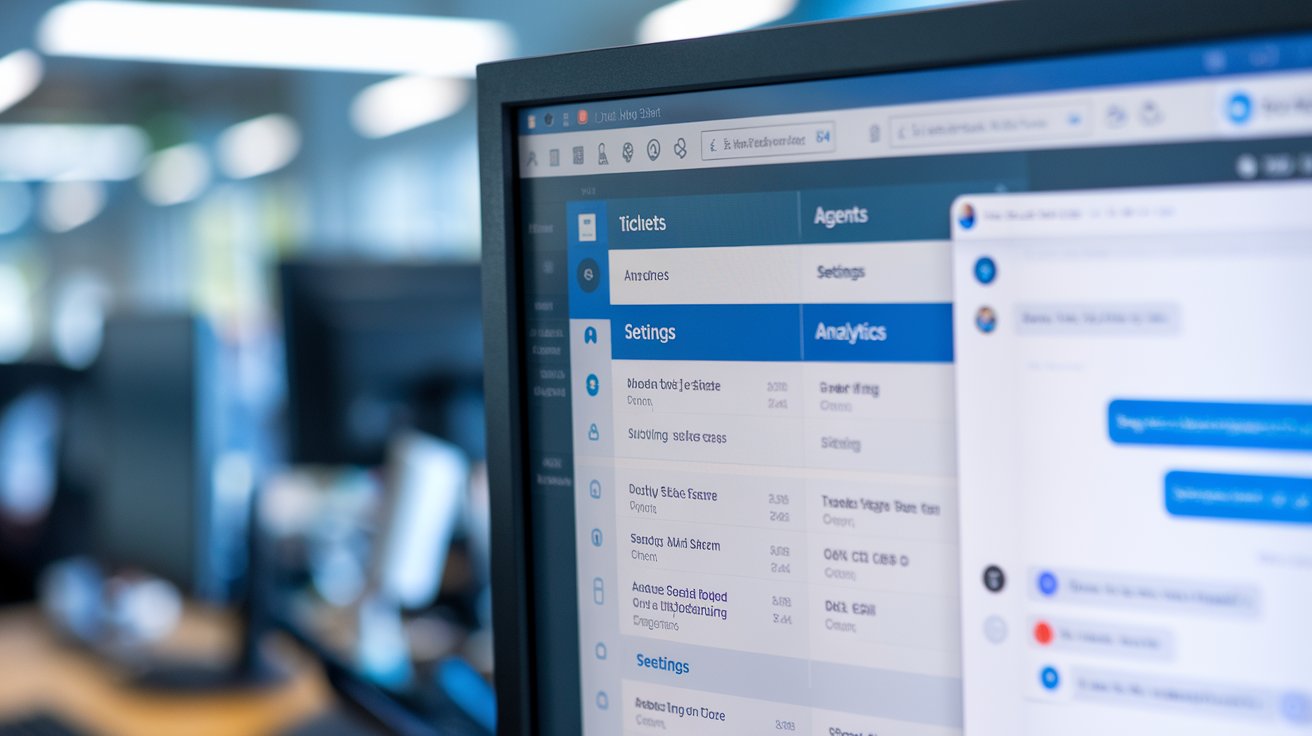Imagine relying on the same IT systems that worked a decade ago, only to find they’re now a bottleneck to growth. As time goes on, you’re constantly patching outdated software, dealing with slow performance, and struggling to integrate new technologies. In contrast, your competitors are using modern, AI-driven IT business solutions that not only enhance efficiency but also minimize downtime. Naturally, it’s frustrating, right?
It’s not just that technology gets old—rather, it’s that traditional IT business solutions aren’t built to adapt to today’s fast-paced, digital-first environment. Consequently, what once felt reliable now feels sluggish, prone to breakdowns, and, worst of all, incapable of supporting your business as it scales. As a result, productivity dips, maintenance costs surge, and you’re stuck in a cycle of reactive problem-solving instead of proactive innovation.
Therefore, as technology continues to advance, small businesses must rethink their IT strategies. While holding onto legacy systems might seem like the safer choice, the reality is that they could be holding your business back. To remain competitive, companies need IT business solutions that are not only agile but also secure and capable of seamless integration.
With that in mind, let’s explore why traditional IT solutions are failing—and how modern, AI-driven alternatives can keep your business ahead.
The Problem with Traditional IT Business Solutions
Lack of Agility in Current IT Business Solutions
Traditional IT systems often struggle to integrate with modern technologies, leading to significant operational inefficiencies (Mendix, n.d.). These legacy systems may use outdated communication protocols and require substantial architectural adjustments to connect with newer applications. For instance, an e-commerce platform built on legacy infrastructure might find it challenging to integrate with contemporary inventory management systems, resulting in manual data entry and increased errors. This lack of flexibility hampers the organization’s ability to respond swiftly to market changes and customer demands.
Costly Maintenance and Upgrades
Maintaining legacy IT systems is not only resource-intensive but also financially burdensome. Organizations often allocate a significant portion of their IT budgets to support these outdated systems, diverting funds from innovative initiatives. According to research, the average enterprise spends approximately 57% of its IT budget on maintaining existing business operations, leaving only around 16% available for innovation (Workday, n.d.). Additionally, the shortage of professionals skilled in outdated technologies further drives up maintenance costs (Incepta Solutions, n.d.; Mendix, n.d.).
Moreover, as these systems age, they become more susceptible to breakdowns, leading to unplanned downtime and disruptions in business operations (Workday, n.d.). The cumulative effect of these challenges can significantly strain an organization’s financial resources and hinder its ability to compete effectively in the market (Mendix, n.d.).
Current IT Business Solutions’ Poor Adaptability to Modern Threats
Legacy systems often lack the robust security features necessary to defend against contemporary cyber threats, making organizations more vulnerable to attacks such as ransomware (Australian Cyber Security Centre, n.d.). For example, outdated software may not receive critical security updates, leaving known vulnerabilities unpatched and exploitable by cybercriminals. The Australian Cyber Security Centre highlighted a case where a New South Wales local council’s reliance on unsupported legacy IT led to a ransomware attack, resulting in significant data encryption and operational disruption (Australian Cyber Security Centre, n.d.).
Such incidents underscore the critical need for organizations to modernize their IT infrastructure to mitigate security risks and ensure compliance with evolving cybersecurity standards.
Addressing these challenges is essential for organizations aiming to enhance operational efficiency, reduce costs, and strengthen their cybersecurity posture. Transitioning to modern, agile IT solutions can provide the flexibility and security needed to thrive in today’s dynamic business environment.
What to Look for in Modern IT Business Solutions
Scalability
Modern IT solutions, especially cloud-based platforms, offer scalability that allows businesses to adjust resources seamlessly as demands evolve (Google Cloud, n.d.). This adaptability ensures optimal system performance without significant upfront infrastructure investment. For instance, scalable cloud storage solutions can easily accommodate increasing data volumes, providing businesses with cost-effective and efficient management of resources (Google Cloud, n.d.).
Automation and AI Integration
Integrating automation and artificial intelligence (AI) into business processes significantly reduces manual tasks and minimizes human errors (Zendesk, n.d.). AI-powered tools efficiently handle repetitive tasks, such as customer inquiries and data entry, allowing staff to focus on more strategic initiatives. A practical example includes AI-driven customer service chatbots that deliver instant responses, substantially enhancing customer satisfaction and operational efficiency (Zendesk, n.d.).
Enhanced Security Measures
Modern IT infrastructures leverage AI-driven security monitoring for proactive threat detection, allowing businesses to respond swiftly before threats escalate (BitLyft, n.d.). AI technologies continuously analyze data patterns and detect anomalies, such as unauthorized login attempts or irregular user behavior. This proactive security approach significantly strengthens an organization’s cybersecurity, protecting sensitive information and preserving trust with customers (BitLyft, n.d.).
Real-World Benefits of AI-Powered IT Business Solutions
Cost Efficiency
One of the most significant advantages of modern IT solutions is cost efficiency. One way to gain that efficiency is through automated processes that reduce the need for manual intervention. This automation minimizes the risk of human error and significantly cutting labor costs (Medvision Solutions, n.d.). An example of this is, automated system updates ensure that critical improvements happen seamlessly, without the need for manual oversight or disruptive downtime. This automation not only minimizes the risk of human error but also significantly reduces labor costs, ultimately leading to improved financial efficiency and resource allocation (Medvision Solutions, n.d.).
Real-Time Data and Insights
In today’s data-driven world, having access to real-time insights can be a game changer for businesses. Predictive analytics, in particular, enables companies to make informed decisions based on data trends rather than guesswork (Hypersonix, n.d.). For example, a retailer using predictive analytics can forecast which products will be in high demand, ensuring optimal stock levels and reducing the risk of overstocking or stockouts. This proactive approach not only improves inventory management but also enhances customer satisfaction by consistently meeting consumer needs (CDW, n.d.).
Beyond retail, real-time data also empowers businesses to monitor operational metrics continuously, identifying inefficiencies before they escalate into larger problems. This insight-driven strategy helps maintain productivity while aligning operations with long-term goals.
Future-Proofing Your Business
Future-proofing means preparing your business to thrive despite evolving challenges and market shifts. Modern IT solutions play a crucial role in this process by offering the flexibility to adapt quickly to changing demands (Noobpreneur, 2025). Whether it’s embracing AI to enhance customer interactions or utilizing cloud infrastructure to scale effortlessly, staying ahead of technological trends keeps businesses competitive.
One key aspect of future-proofing is building systems that evolve with your organization’s needs. As customer expectations and industry standards change, modern IT solutions ensure you can pivot without significant disruption. This strategic foresight not only safeguards current operations but also positions the business for sustainable growth (Allwork.Space, 2023).
How to Make the Transition
Transitioning to modern IT solutions is a strategic process that requires careful planning and execution. Here’s a structured approach to ensure a smooth transformation:
Assess Your Current Infrastructure
Begin by conducting a thorough evaluation of your existing IT infrastructure to identify areas that need improvement. Key steps include:
- Identify Pain Points and Limitations: Look for recurring issues or trends that indicate systemic problems within the IT infrastructure, such as performance bottlenecks or security gaps. razor-tech.com+1Lansweeper+1
- Evaluate Compliance and Security: Ensure your current systems meet regulatory requirements and assess their resilience against modern cyber threats.
- Review Scalability: Determine if your infrastructure can handle future growth and increased workloads. ion247.com+2rightpeoplegroup.com+2Core BTS+2
Research Modern IT Business Solutions
Once you’ve identified the shortcomings of your current infrastructure, explore contemporary IT solutions that align with your business objectives:
- Focus on AI Integration and Scalability: Modern IT solutions often incorporate artificial intelligence to enhance efficiency and scalability. For instance, AI-driven integration platforms can significantly improve operational efficiency and system reliability. ResearchGate
- Consider Hybrid Cloud Architectures: Hybrid cloud strategies allow organizations to distribute workloads based on performance and security needs, providing flexibility and scalability. Arion Research
- Evaluate Vendor Offerings: Research providers that offer solutions tailored to your industry and business size, ensuring they can meet your specific requirements.
Plan a Phased Implementation
Implementing new IT solutions should be approached methodically to minimize disruption:
- Develop a Phased Approach: Introduce new systems in stages, allowing for testing and adjustments before full deployment. This strategy helps manage change effectively and reduces the risk of operational disruptions.
- Prioritize Critical Systems: Begin with areas that will benefit most from modernization, ensuring that essential functions are enhanced first.Quixy
- Allocate Resources and Training: Ensure that staff are adequately trained for each phase and that resources are available to support the transition.
By systematically assessing your current infrastructure, researching suitable modern solutions, and executing a phased implementation plan, your organization can transition smoothly to a more efficient and scalable IT environment.
Conclusion
Holding onto traditional IT solutions might feel familiar, but it’s increasingly risky. As technology continues to advance, businesses that fail to modernize their IT infrastructure risk falling behind their more agile, efficient competitors. Modern, AI-driven solutions offer scalability, cost efficiency, real-time insights, and robust security—all essential for thriving in today’s digital economy.
Ready to future-proof your business? Start by reimagining your IT strategy today. At IMRS, we specialize in providing smart IT solutions tailored to support your business’s profitability and scalability. Our services include strategic consulting, custom software development, AI-powered automation, and managed IT with cloud security. By partnering with IMRS, you can leverage cutting-edge technologies to streamline operations, enhance security, and drive growth. Ready to future-proof your business? Contact us today to discover how our professional services can transform your IT strategy.
Sources
- Mendix. (n.d.). Why the cost of maintaining legacy systems only grows over time. Mendix Blog. Retrieved April 7, 2025, from https://www.mendix.com/blog/why-the-cost-of-maintaining-legacy-systems-only-grows-over-time/
- Workday. (n.d.). Legacy systems: The hidden costs of planning. Workday Blog. Retrieved April 7, 2025, from https://blog.workday.com/en-gb/legacy-systems-hidden-costs-planning.html
- Incepta Solutions. (n.d.). The hidden costs of legacy systems: Beyond financial burdens. Incepta Solutions Blog. Retrieved April 7, 2025, from https://www2.inceptasolutions.com/the-hidden-costs-of-legacy-systems-beyond-financial-burdens
- Australian Cyber Security Centre. (n.d.). Managing risks of legacy IT: Executive guidance. Australian Cyber Security Centre. Retrieved April 7, 2025, from https://www.cyber.gov.au/resources-business-and-government/maintaining-devices-and-systems/system-hardening-and-administration/legacy-it-management/managing-risks-legacy-it-executive-guidance
- Google Cloud. (n.d.). Advantages and disadvantages of cloud computing. Google Cloud. Retrieved April 7, 2025, from https://cloud.google.com/learn/advantages-of-cloud-computing
- Zendesk. (n.d.). AI in customer service: All you need to know. Zendesk Blog. Retrieved April 7, 2025, from https://www.zendesk.com/blog/ai-customer-service/Zendesk
- BitLyft. (n.d.). How AI enhances threat detection in MDR services. BitLyft Resources. Retrieved April 7, 2025, from https://www.bitlyft.com/resources/how-ai-enhances-threat-detection-in-mdr-services
- Allwork.Space. (2023, May). Adapt or die: Future-proof your business with these essential tips. Retrieved April 7, 2025, from https://allwork.space/2023/05/adapt-or-die-future-proof-your-business-with-these-essential-tips/?utm_source=chatgpt.com
- CDW. (n.d.). Predictive analytics in retail: How your organization can forecast success. Retrieved April 7, 2025, from https://www.cdw.com/content/cdw/en/articles/dataanalytics/predictive-analytics-retail-how-your-organization-can-forecast-success.html?utm_source=chatgpt.com
- Hypersonix. (n.d.). Benefits of predictive analytics in retail demand forecasting. Retrieved April 7, 2025, from https://hypersonix.ai/blogs/benefits-of-predictive-analytics-in-retail-demand-forecasting?utm_source=chatgpt.com
- Limble CMMS. (n.d.). 7 ways technology reduces maintenance costs. Retrieved April 7, 2025, from https://limblecmms.com/blog/how-technology-reduces-maintenance-costs/?utm_source=chatgpt.com
- Medvision Solutions. (n.d.). Reducing costs: Your guide to automating outdated manual tasks. Retrieved April 7, 2025, from https://www.medvision-solutions.com/blog/reducing-costs-your-guide-to-automating-outdated-manual-tasks?utm_source=chatgpt.com
- Noobpreneur. (2025, April 5). A guide to future-proofing your business. Retrieved April 7, 2025, from https://www.noobpreneur.com/2025/04/05/a-guide-to-future-proofing-your-business-for-an-evolving-market/?utm_source=chatgpt.com
- Arion Research. (n.d.). Hybrid cloud strategies for modern IT management. Retrieved April 7, 2025, from https://www.arionresearch.com/blog/ow4llblb08yiltdico9e4905i697t9?utm_source=chatgpt.com
- DivergeIT. (n.d.). Challenges of managing IT infrastructure. Retrieved April 7, 2025, from https://www.divergeit.com/blog/challenges-managing-it-infrastructure?utm_source=chatgpt.com
- Razor Technology. (n.d.). Evaluating your IT infrastructure: A comprehensive assessment guide. Retrieved April 7, 2025, from https://www.razor-tech.com/insights/evaluating-your-it-infrastructure-a-comprehensive-assessment-guide/?utm_source=chatgpt.com
- ResearchGate. (n.d.). The transformative impact of AI on modern system integration. Retrieved April 7, 2025, from https://www.researchgate.net/publication/387865479_The_Transformative_Impact_of_AI_on_Modern_System_Integration?utm_source=chatgpt.com
- Tools4ever. (n.d.). What is phased implementation? Retrieved April 7, 2025, from https://www.tools4ever.com/glossary/what-is-phased-implementation/?utm_source=chatgpt.com

